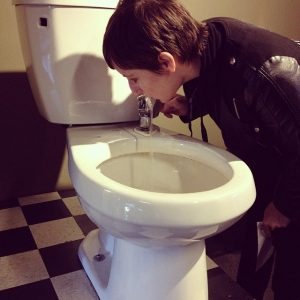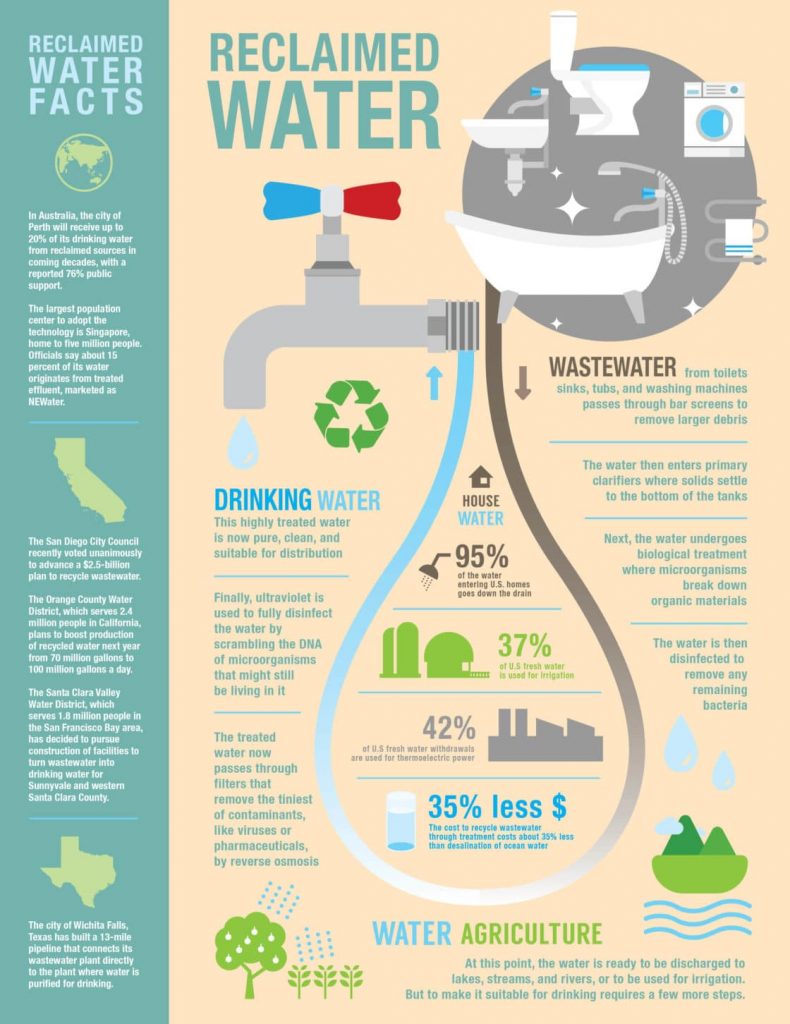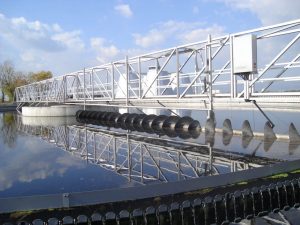Reclaimed Water — From Toilet to Tap Infographic
Reclaimed Water — From Toilet to Tap Infographic

Would you drink water that was once used in the toilet? Chances are you just gave an emphatic “no”. But what if that water is actually so highly treated and processed that it is actually cleaner than the water currently coming out of most people’s taps? For the overwhelming majority of people, their answer is still that same emphatic “no”. Commonly referred to as the “yuck factor”, the idea of drinking recycled wastewater is simply too much for the human mind to overcome. However, climate change, population growth, and overuse have strained freshwater resources, and people may just need to change their way of thinking.
A Limited and Precious Resource
In the developed world, fresh water is taken for granted, when it is in fact a limited resource. About 97% of the Earth’s water is saltwater. More than two-thirds of the remaining fresh water is frozen in glaciers, which leaves less than 1% of the Earth’s water as fresh and available. In addition, the global population is growing astronomically at the same time that historic droughts plague Australia and the United States, two of the world’s largest water consumers. Los Angeles, Las Vegas, and Phoenix are three of the driest cities in America, and they are also experiencing some of the highest rates of population growth. Conservation isn’t working, water supplies are running dry, and the most drought-stricken areas are looking, albeit reluctantly, to reclaimed wastewater.
“When we talk about reclaimed wastewater, we’re not talking about something that’s simply at the level of convenience,” says David Feldman, a political scientist at the University of California at Irvine. “We’re really dealing with an issue that is going to be affecting every country, every society.” Avoiding future clashes over water, he says, will mean having to drink treated wastewater.
There is no doubt that we all drink water that has passed through a human or animal at some point. The Earth’s water is a finite resource that constantly cycles, and treated wastewater is frequently discharged into lakes and rivers that supply drinking water. But while most people have no problem drinking water from sources that have been augmented with treated wastewater, the thought of taking water flushed down the toilet and directly repurposing it into drinking water is a bit tough to, well…swallow.

Reclaimed Water Usage Today
Singapore is arguably the world’s most well-known and successful wastewater recycler. Their reclaimed water, branded as NEWater, supplies 15 percent of the population’s water, and is considered cleaner and purer than any tap water. In Australia, the city of Perth will receive up to 20% of its drinking water from reclaimed sources in coming decades. And, through public education and marketing efforts, the Perth project has a reported 76% public support.
Similar efforts are also in progress in the U.S. In San Diego, a 2004 survey indicated that 63 percent of county residents opposed adding treated wastewater to the drinking water supply. But as the drought has worsened and the population has grown, the city is running out of options. Therefore, the San Diego County Water Authority turned to community and environmental groups to help educate the public about the safety of recycled water, and in November, 2014, the San Diego City Council voted unanimously to advance a $2.5 billion plan to recycle wastewater. What’s more, recent polls show that opposition to reclaimed water has fallen to only 25 percent.
The Orange County Water District, which serves 2.4 million people in California, plans to boost production of recycled water next year from 70 million to 100 million gallons per day. And, the Santa Clara Valley Water District, which serves 1.8 million people in the San Francisco Bay area, has decided to pursue construction of facilities to turn wastewater into drinking water for Sunnyvale and western Santa Clara County.
In Texas, the drought-stricken city of Wichita Falls has built a 13-mile pipeline that connects its wastewater plant directly to the plant where water is purified for drinking. In addition, the Colorado River Municipal Water District has been piping treated effluent from a wastewater treatment plant in Big Spring, Texas to a drinking-water plant that serves Big Spring, Snyder, Midland and Odessa for more than a year.
Explaining the Treatment Process
 Education is the key to making recycled wastewater — or reclaimed water — more palatable, and explaining the process of water treatment is the most critical step in changing public opinion. When a person flushes a toilet, wastewater is carried through sewers to a municipal wastewater treatment plant. There, large solid material is separated from liquid with grates or bar screens. Next, the wastewater enters a settling tank where smaller solids fall out of solution and oils rise to the surface where they are skimmed off. The wastewater next moves to an aeration tank, where microbes feed on the waste and break it down. The water is then disinfected with chemicals such as bleach and chlorine. After an additional settling step, the treated water undergoes reverse osmosis where it passes through filters that remove even the tiniest of contaminants, like viruses or pharmaceuticals. Finally, the water is treated with ultraviolet light to fully disinfect the water by scrambling the DNA of anything that might still be living in it. This highly treated water is actually cleaner and more pure than most water currently pouring from our taps.
Education is the key to making recycled wastewater — or reclaimed water — more palatable, and explaining the process of water treatment is the most critical step in changing public opinion. When a person flushes a toilet, wastewater is carried through sewers to a municipal wastewater treatment plant. There, large solid material is separated from liquid with grates or bar screens. Next, the wastewater enters a settling tank where smaller solids fall out of solution and oils rise to the surface where they are skimmed off. The wastewater next moves to an aeration tank, where microbes feed on the waste and break it down. The water is then disinfected with chemicals such as bleach and chlorine. After an additional settling step, the treated water undergoes reverse osmosis where it passes through filters that remove even the tiniest of contaminants, like viruses or pharmaceuticals. Finally, the water is treated with ultraviolet light to fully disinfect the water by scrambling the DNA of anything that might still be living in it. This highly treated water is actually cleaner and more pure than most water currently pouring from our taps.
Getting Past the “Yuck Factor”
 Technologies being developed today will make wastewater recycling more efficient and less expensive, but changing people’s opinion of drinking “toilet to tap” is the bigger challenge, experts say. Studies show that human beings naturally possess a strong aversion to consuming any food or drink that could possibly contain pathogens. However, there are some steps that can be taken to change public opinion. Adding an extra step in the treatment process, like discharging treated wastewater to a river that then carries it from one city to a drinking water treatment plant in another city, can eliminate the mental stigma. Discharging wastewater into rivers and aquifers instead of water pipes is more expensive but may be useful for gaining public acceptance. Public information campaigns that emphasize economic benefits, protection of U.S. water supplies, and personal safety can also increase public support. In addition, endorsement by a trusted group, like the Surfrider Foundation who helped raise support for wastewater reuse in San Diego, can also reduce stigma.
Technologies being developed today will make wastewater recycling more efficient and less expensive, but changing people’s opinion of drinking “toilet to tap” is the bigger challenge, experts say. Studies show that human beings naturally possess a strong aversion to consuming any food or drink that could possibly contain pathogens. However, there are some steps that can be taken to change public opinion. Adding an extra step in the treatment process, like discharging treated wastewater to a river that then carries it from one city to a drinking water treatment plant in another city, can eliminate the mental stigma. Discharging wastewater into rivers and aquifers instead of water pipes is more expensive but may be useful for gaining public acceptance. Public information campaigns that emphasize economic benefits, protection of U.S. water supplies, and personal safety can also increase public support. In addition, endorsement by a trusted group, like the Surfrider Foundation who helped raise support for wastewater reuse in San Diego, can also reduce stigma.
Running Out of Options
Population growth, depleted resources, climate change, and severe drought have all impacted our water supply. Reports have stated that California will run out of water by 2016. In Las Vegas, Lake Mead has shrunk to 60% of the size it was two decades ago. Wichita Falls, Texas is under a Stage 5 Drought Catastrophe. Conservation efforts have failed, our water supplies are drying up, and municipalities do not have the resources to supply enough water to the public. While the thought of drinking treated wastewater may be repugnant, it is only a matter of time before we run out of options. Notes Feldman, “I think between climate change, increased urbanization, and growing demands for food and energy, there’s really no way around reusing wastewater.” And unless something drastically changes, repurposing wastewater will not only be accepted in the future, but commonplace.
